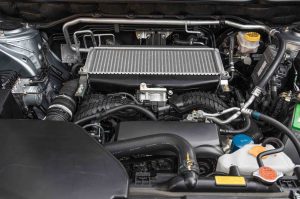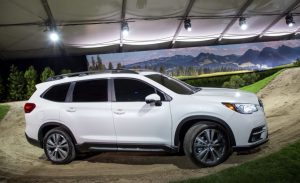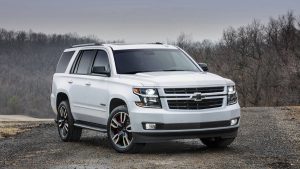Guest Post by Eric Peters

One of the many cons being perpetrated upon the car-buying public is that the very small, very turbocharged four cylinder engines being served up as replacements for “thirsty” V6 and even V8 engines in larger vehicles especially are money-savers.
Hell, they hardly save much gas.
And they cost in other – hidden – ways.
Consider, as an example of the trend, the stats of the 2019 Subaru Ascent vs. those of the Chevy Tahoe. The former is representative of the New School while the Chevy is as Old School as it gets in anything new.
Both are big – and heavy – vehicles. Each seat up to eight people in three rows. But the Ascent – which is a car-based crossover SUV – has a very small-for-its-size engine, just 2.5 liters and 260 hp to haul around its 4,430 lbs. (that’s empty, before even the driver climbs on board). The EPA says it gets 20 city, 26 highway – best case.
I have been test-driving this vehicle for several days and am averaging 22.8 MPG, according to the car’s computer.
The Tahoe is also a big vehicle and a much heavier vehicle – by more than 1,000 lbs. Because it’s a truck-based SUV, with a heavier-duty frame and truck-type 4WD gear (including a two-speed transfer case) vs. the Subaru’s lighter-duty all-wheel-drive system. Unlike the Soobie, the Chevy has a big V8 under its hood – 5.3 liters and 355 horsepower, which is more than twice the size of the Subaru’s engine and almost 100 hp stronger.
And yet, it hardly uses much more gas.
The EPA says 16 city, 23 highway – which amounts to a difference without much distinction of just 4 MPG in city driving and 3 MPG on the highway. I’ve driven several new Tahoes over the years and they also average about what what the Soobie averages.
But the Chevy is much stronger, much more capable vehicle. For example, it can tow 8,400 lbs. vs. several thousand pounds less for the Subaru.
And much quicker, too.
Zero to 60 in just 5.8 seconds vs. 7.3 seconds for the lighter, smaller-engined, but not-much-smaller Subaru (which is about 197 inches long overall vs. 204 inches for the Tahoe).
So, what’s the upside to the Subaru’s downsized engine? It is hard to figure.
It is becoming practice to put undersized engines in overisized vehicles. Mazda, for example, sells a vehicle that is a direct apples-to-apples cross shop of the Ascent, the CX-9. It is also a large, car-based crossover SUV with three rows of seats . . . and a very small (2.5 liters) engine under its hood.
It also rates 20 city, 26 highway according to the EPA – like its Subaru rival.
Now, vehicles like the Ascent and the CX-9 never came with V8s; that would be over-engining them. But they did used to come with size-appropriate V6 engines and – shocking, as Geraldo used to say all the time – they didn’t use much more fuel, either.
For example, the 2015 Mazda CX-9, which was available with a 3.7 liter V6, rated 17 city, 24 highway – a difference of 3 MPG in city driving and just 2 MPG on the highway. It’s such a small difference as to make no meaningful difference – in terms of what you paid for gas.
Power/performance is one way.
The CX-9’s no-longer-available 3.7 liter V6 was much stronger than the turbo 2.5 liter four which replaced it – 273 hp then vs. 225 hp now, a difference of almost 50 hp, which is a difference with a distinction.
Another is stress – and expense.
Undersized engines rely on turbo boost as the replacement for displacement. The theory is that you’ll use less gas when the engine isn’t being turbo-boosted. Which is fine – and true – when the engine is idling and the car isn’t moving.
The reality is that because the engines are too small (and not strong enough on their own) to adequately propel the vehicles they’re tasked with moving, they are on boost almost all the time once they’re not sitting still. The turbo boosts the power to adequate-engine levels, but also results in about the same amount of fuel being used by an engine that is working harder to make it and meanwhile, as a result, its internal parts are subjected to higher stress because of the higher pressure experienced inside a turbo engine.
An engine that isn’t turbocharged sucks air into its cylinder via the vacuum – negative pressure – created by the pistons as they travel downward, inhaling (so to speak) the air that will be mixed with fuel to create the explosion which makes the power to propel the vehicle. A turbocharged engine is force-fed air, which is crammed into its cylinders under positive pressure (boost) which is typically in the range of 18-22 pounds per square inch.
Turbocharged engines can be built with tougher internals, to withstand the additional pressure – but the fact remains they are subjected to higher pressure (and stress) than engines which are not force-fed air. And no matter how tough-built they are, they are built with additional parts – the turbocharger and all its related bits and pieces. This adds certain expense up front – when you buy the car so equipped – and at least possible expense down the road, in the event a problem develops with the turbo and/or any of its related bits and pieces.
It is impossible for such problems to develop with a non-turbocharged engine, because there is no turbo – nor turbo-related bits and pieces, either.
This is why – historically – turbocharged engines were used almost exclusively as power-enhancers (rather the displacement replacers) in high-performance vehicles, usually sports cars and sport sedans.
Now they are being used in mass-market, daily-driven family vehicles like the Ascent and CX-9 and many others.
All for the sake of maybe 3-4 MPG.
On paper.
Which makes no sense except in the context of the car companies being desperate to eke out fractional fuel efficiency gains, in order to keep pace with the government’s none-of-its-business demands that our new cars get ever-higher-mileage.
No matter how little it actually turns out to be – and regardless of how much it costs us.







I wonder if there is an equivalent Auto app of the cat big block twin turbo in class 8 trucks?
My friends 2015 ford f150 eco boost already ate a 5400 dollar turbo. My 5.7 ram v8 gets 21.8 mpg, and 14.7 towing a load of 8000lbs inc trailer. The thing is idling at 1700 rpm at 73 mph. It will last forever. Underpowered shitboxes turning 4500 rpm everywhere they go wont last.
The cars built today are too complicated, too damn heavy, and have NO useful interior space. Look at the rear seat room in this 1940 Nash Lafayette having a 117″ wheelbase and weight of 3235 lbs (Tojo Camry having a 111″ wheelbase is at 3240 lbs). [/img]
[/img]
The Nash Lafayette had a cast iron inline six with NO exhaust manifold and NO intake manifold for much lower maintenance and these cars got in the high 20’s for fuel economy.
[img
[img [/img]
[/img]
None of my GM 4×4’s (pickups, suburbans, AWD vans) ever got anything resembling 20 mpg. My Subaru Outback with 2.5/175 hp will run 75 all day long with the AC blasting and get 35+ and nothing ever goes wrong with it. No brake job every 30,000 miles, no replace all the f’ing tie rods every 40-50,000. No AC refrigerant lines corroding from road salt, no transmission going out every few years which happened on every GM van or truck I have owned that I kept over 50,000 miles……..one could go on. I call bullshit on this article.
I was down in Lexington one time coming from a doctor’s appointment and came upon a brand new Subaru that just hit one of those piece of crap Dodge 200’s. The driver of the Dodge was at fault, for he pulled out of a parking lot in front of the Subaru. The ENTIRE front end of the Subaru was shoved up to the windshield, and the Dodge had a dent about as big around as a basketball on the driver side front fender. That Subaru was obviously totaled. Holy shit, the Japs must be using steel in their unibodies with the thickness of one of those old steel Stroh’s Beer cans! Imagine what one would look like when it hits a 12 point 300 pound buck at 60 mph. I know of a guy with a brand new 2018 Nissan Maxima who did that and it TOTALED the car.
The problem remains, you drive a Subaru Outback. Only for lesbian cops.
I have a Ford Fusion with the 1.6L EcoBoost engine. It can get the advertised 37mpg on the highway as I have done this twice but the conditions have to be right and you cannot go over 65. Most of the time highway mileage is 31-33 running the AC at 75mph.
The city driving is where it goes to crap. If I am driving very conservatively I can get 26-28. If my wife drives the city mileage drops to 21-22. If I drive it like I drive my Ranger it is down to 18. This is not a heavy car. It weighs just under 400 lbs more than our Mini Cooper which has the same sized turbo motor.
I have a cousin that works at Ford. His view on it is the EcoBoost in a truck should last 150k before an engine related problem occurs and a NA V8 will go beyond 200K easily. He has been buying a new car for his wife every other year and a new truck for him on the off years. Since the EcoBoost has come out he has gotten the largest EB engine available. He just got his wife the Lincoln with the hybrid engine and told her that she would be putting 100K on it before she get a new car. His plan is to buy a F-250 with the gas engine next year when he retires in hopes that it will last well over 200K.